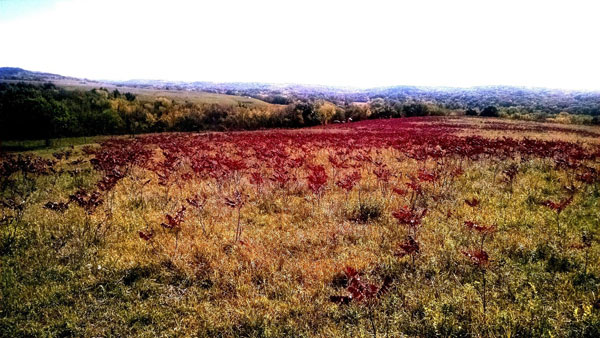The tannic acid produced by the smooth sumac was once used to tan leather to make shoes, hence the name ‘sumac’ (from shoe make). The red leaves of smooth sumac are very noticeable this time of year, making it a timely focus for the October World of Weeds article (Figure 1).

Figure 1. Smooth sumac thicket in Kansas rangeland. Photo by Walt Fick, K-State Research and Extension.
Ecology of smooth sumac
Smooth sumac (Rhus glabra) is a perennial shrub native to North America. It reproduces by both rhizomes and seeds to form dense thickets, especially in pastures and rangeland throughout Kansas
Identification
Smooth sumac seedlings have oblong cotyledons and smooth petioles. Mature plants can reach up to 20 feet tall. Its stems are red to purple when young and turn grey to brown when older. They can be up to 7 inches in diameter.
Smooth sumac has alternate leaves 12 to 20 inches long that are composed of 11 to 29 leaflets. Each leaflet is 1.5 to 3 inches long with serrated margins and fine hairs on the lower surface. Flowers are yellowish-green with 5 petals and found in pyramid-shaped inflorescences 4 to 10 inches long, somewhat resembling an open milo head. Each inflorescence contains both male and female flowers. The fruit is a dark red, hairy flattened sphere with a single, straw-colored seed.
Management
Smooth sumac is not controlled by spring burning, however a number of herbicides can control it. Some of the recommended products include Grazon P+D alone or with Remedy Ultra, as well as 2,4-D and Chaparral + 2,4-D. Repeated mowing at the bud stage will provide control of smooth sumac.
The use of trade names is for clarity to readers and does not imply endorsement of a particular product, nor does exclusion imply non-approval. Always consult the herbicide label for the most current use requirements.
Sarah Lancaster, Extension Weed Science Specialist
slancaster@ksu.edu
Walt Fick, Rangeland Management Specialist
whfick@ksu.edu
Tags: World of Weeds smooth sumac